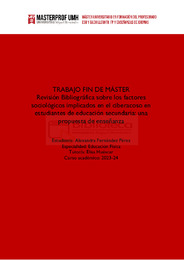Por favor, use este identificador para citar o enlazar este ítem:
https://hdl.handle.net/11000/32901Registro completo de metadatos
| Campo DC | Valor | Lengua/Idioma |
|---|---|---|
| dc.contributor.advisor | Huéscar Hernández, Elisa | - |
| dc.contributor.author | Fernández Pérez, Alexandra | - |
| dc.contributor.other | Departamentos de la UMH::Psicología de la Salud | es_ES |
| dc.date.accessioned | 2024-09-02T11:57:31Z | - |
| dc.date.available | 2024-09-02T11:57:31Z | - |
| dc.date.created | 2024-06 | - |
| dc.identifier.uri | https://hdl.handle.net/11000/32901 | - |
| dc.description | Especialidad: Educación Física | es_ES |
| dc.description.abstract | El presente estudio trata de descubrir mediante la literatura científica cuales son los factores sociológicos implicados en el ciberacoso en estudiantes pertenecientes a la educación secundaria. También de diseñar una propuesta de enseñanza para prevenir el ciberacoso mediate los factores sociológicos relacionados con la institución escolar. Para ello, se llevará a cabo una revisión bibliográfica de la literatura científica mediante el método Preferred Reporting Items for Systematic Reviews and Meta-Analyse-PRISMA. Los resultados muestran que la relación de familia, los docentes y el grupo de iguales son los factores sociológicos más importantes implicados en el acoso escolar, es clave que los progenitores comuniquen con sus hijos y mantengan un alto grado de participación en el centro docente. De igual modo, desde el centro docente se ha de promover una comunicación positiva y las relaciones prosociales con el grupo de iguales. Por otro lado, para afrontar este maltrato es importante trabajar de forma conjunta los docentes y los equipos multiprofesionales del centro docente para poder prevenir este problema desde el principio y poder proporcionar a las víctimas una solución | es_ES |
| dc.description.abstract | The present study tries to discover through scientific literature what are the sociological factors involved in cyberbullying in students belonging to secondary education. Also to design a teaching proposal to prevent cyberbullying through sociological factors related to the school institution. To do this, a bibliographic review of the scientific literature will be carried out using the Preferred Reporting Items for Systematic Reviews and Meta-Analyse-PRISMA method. The results show that the family relationship, teachers and the peer group are the most important sociological factors involved in bullying; it is key that parents communicate with their children and maintain a high degree of participation in the school. Likewise, positive communication and prosocial relationships with the peer group must be promoted from the teaching center. On the other hand, to confront this abuse, it is important to work together with the teachers and the multi-professional teams at the educational center to be able to prevent this problem from the beginning and be able to provide the victims with a solution | es_ES |
| dc.format | application/pdf | es_ES |
| dc.format.extent | 29 | es_ES |
| dc.language.iso | spa | es_ES |
| dc.publisher | Universidad Miguel Hernández | es_ES |
| dc.rights | info:eu-repo/semantics/openAccess | es_ES |
| dc.rights.uri | http://creativecommons.org/licenses/by-nc-nd/4.0/ | * |
| dc.subject | Ciberacoso | es_ES |
| dc.subject | Factores sociológicos | es_ES |
| dc.subject | Adolescentes | es_ES |
| dc.subject | Educación secundaria | es_ES |
| dc.subject.other | CDU::3 - Ciencias sociales::37 - Educación. Enseñanza. Formación. Tiempo libre | es_ES |
| dc.title | Revisión bibliográfica sobre los factores sociológicos implicados en el ciberacoso en estudiantes de educación secundaria: una propuesta de enseñanza | es_ES |
| dc.type | info:eu-repo/semantics/masterThesis | es_ES |

Ver/Abrir:
TFM Fernández Pérez, Alexandra.pdf
277,49 kB
Adobe PDF
Compartir:
 La licencia se describe como: Atribución-NonComercial-NoDerivada 4.0 Internacional.
La licencia se describe como: Atribución-NonComercial-NoDerivada 4.0 Internacional.
.png)